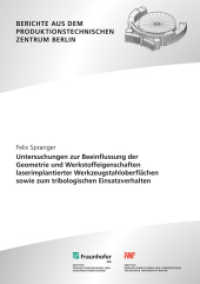Full Description
The flux,preservation,and accumulation of organic carbon in marine systems are controlled by various mechanisms including primary p- duction of the surface water,supply of terrigenous organic matter from the surrounding continents, biogeochemical processes in the water column and at the seafloor, and sedimentation rate. For the world's oceans,phytoplankton productivity is by far the largest organic carbon 9 source,estimated to be about 30 to 50 Gt (10 tonnes) per year (Berger et al. 1989; Hedges and Keil 1995). By comparison, rivers contribute -1 about 0. 15 to 0. 23 Gt y of particulate organic carbon (Ittekkot 1988; -1 Hedges et al. 1997). On average,only about 0. 1-0. 2 Gt y of the organic carbon supplied to the world's oceans has been buried in Holocene sediments, with perhaps 85-90% of that being deposited in deltaic, shelf and upper slope sediments (Romankevich 1984; Berner 1989; Hedges and Keil 1995). To refine the global ocean carbon budget in general and,specifically,to quantify organic carbon burial because it is so important for climatic change, we need detailed measurements of the organic carbon flux in all ocean environments, especially for c- tinental margins (e. g.
,Liu et al. ,2000). With the notable exception of the Arctic Ocean, data have been available for some time on organic carbon sources, pathways and burial in a variety of ocean envir- ments.
Contents
1 The Arctic Ocean: Boundary Conditions and Background Information.- 1.1 Physiography and Bathymetry of the Arctic Ocean.- 1.2 The Arctic Ocean: Modern Status and Recent Climate Change.- 1.3 The Tectonic Evolution of the Arctic Ocean: Overview and Perspectives.- 1.4 Geochemical Proxies Used for Organic Carbon Source Identification in Arctic Ocean Sediments.- 2 Modern Terrigenous Organic Carbon Input to the Arctic Ocean.- 2.1 General Introduction.- 2.2 River Input.- 2.3 Organic Carbon Input to the Artic Seas Through Coastal Erosion.- 2.4 The Role of Arctic Sea Ice in Transporting and Cycling Terrestrial Organic Matter.- 2.5 Aeolian Input.- 2.6 Summary and Concluding Remarks.- 3 Primary and Secondary Production in the Arctic Seas.- 3.1 Introduction.- 3.2 Major Algal Groups and Their Distribution.- 3.3 Limitation and Control of Primary Production.- 3.4 Primary Production and Growth Rate.- 3.5 Seasonality.- 3.6 Distribution of Primary Production.- 3.7 Mesozooplankton.- 3.8 Primary Production — Impact of Climate Change.- 3.9 Summary and Concluding Remarks.- 4 The Role of Dissolved Organic Matter for the Organic Carbon Cycle in the Arctic Ocean.- 4.1 Introduction.- 4.2 Riverine DOM on Arctic Shelves and Beyond.- 4.3 Distribution, Chemical Composition, and Fluxes of Marine DOM in the Central Arctic Ocean.- 4.4 Summary and Concluding Remarks.- 5 Particulate Organic Carbon Flux to the Arctic Ocean Sea Floor.- 5.1 Introduction.- 5.2 What do we Know About Vertical Carbon Flux from the Arctic Ocean.- 5.3 Case Studies.- 5.4 Regional Variability in POC Export Flux in the Arctic Ocean Determined Using 234Th as a Tracer.- 5.5 Particulate Organic Carbon Flux to the Seafloor of the Arctic Ocean: Quantity, Seasonality and Processes.- 5.6 Summary and Concluding Remarks.- 6 The Benthos ofArctic Seas and its Role for the Organic Carbon Cycle at the Seafloor.- 6.1 Introduction.- 6.2 Origin and Evolution of Arctic Habitats and Species.- 6.3 Food Supply of the Arctic Benthos: Sources and Pathways.- 6.4 Benthic Communities of the Arctic Seas.- 6.5 Organic Carbon Utilization by the Arctic Benthos.- 6.6 Summary and Concluding Remarks.- 7 Organic Carbon in Arctic Ocean Sediments: Sources, Variability, Burial, and Paleoenvironmental Significance.- 7.1 Organic Carbon in Arctic Ocean Sediments: A General Introduction.- 7.2 The Beaufort Sea: Distribution, Sources, Fluxes, and Burial Rates of Organic Carbon.- 7.3 The Continental Margin of the North Bering-Chukchi Sea: Distribution, Sources, Fluxes, and Burial Rates of Organic Carbon.- 7.4 The East Siberian Sea: Distribution, Sources, and Burial of Organic Carbon.- 7.5 The Laptev Sea: Distribution, Sources,Variability and Burial of Organic Carbon.- 7.6 The Kara Sea: Distribution, Sources,Variability and Burial of Organic Carbon.- 7.7 The Barents Sea: Distribution, Sources,Variability and Burial of Organic Carbon.- 7.8 Northern Fram Strait und Yermak Plateau: Distribution,Variability and Burial of Organic Carbon and Paleoenvironmental Implications.- 7.9 The Central Arctic Ocean: Distribution, Sources, Variability and Burial of Organic Carbon.- 8 Organic Carbon Budget: Arctic Ocean vs. Global Ocean.- 8.1 Introduction.- 8.2 Global Organic Carbon Fluxes: Sources and Sinks.- 8.3 Arctic Ocean Organic Carbon Fluxes: Sources and Sinks.- 8.4 Summary and Concluding Remarks.- 9 References.








